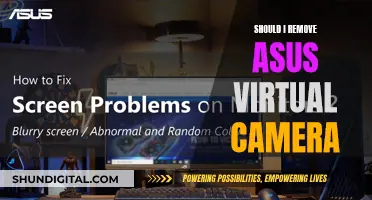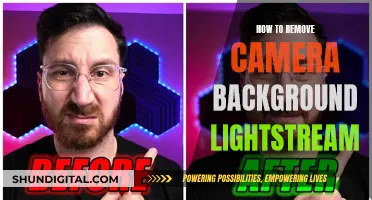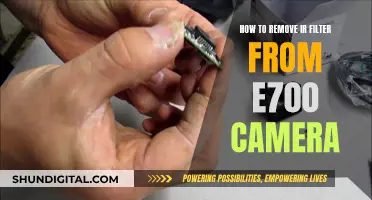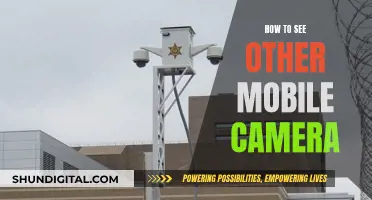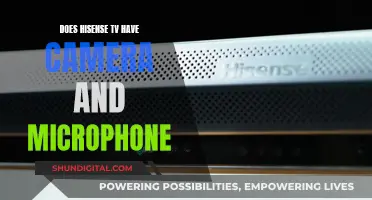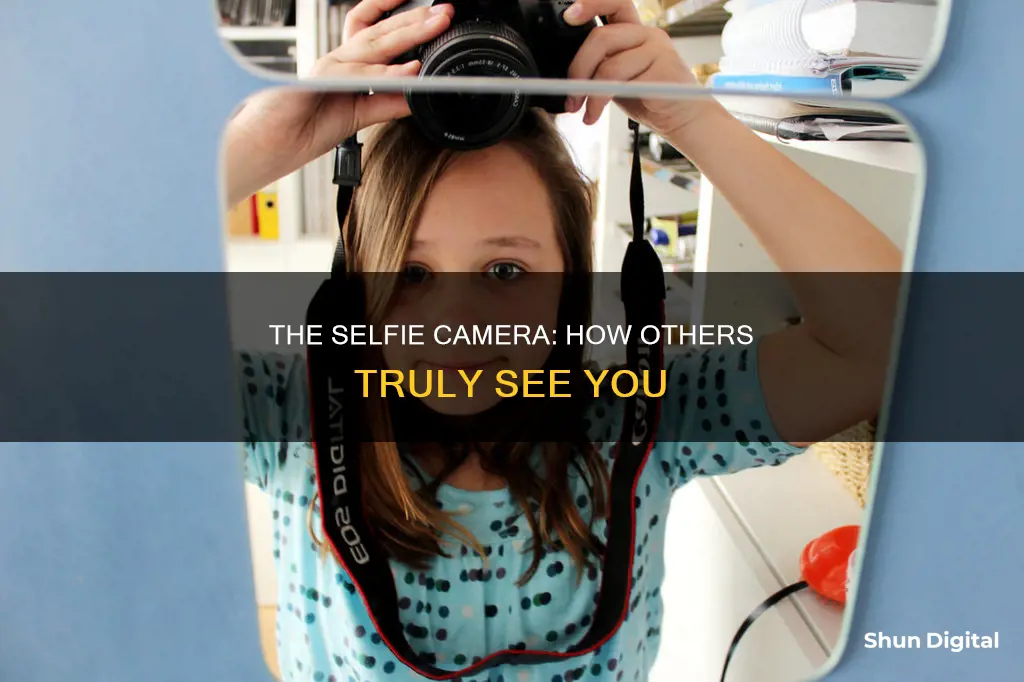
The selfie camera is not how others see you. The front-facing camera on your phone distorts your features and doesn't give you a clear representation of how you look. The closer the camera is to your face, the more distorted your features will appear. This is because the camera is mono-vision and can't account for spatial relationships between objects in the same way the human eye can.
If you want to see how others see you, hold your phone away from you and zoom in. Alternatively, look in a mirror—this will show your true image. However, it's important to remember that no photo can capture your true appearance. All photos are lies and distortions of the truth.
What You'll Learn
- Selfie cameras distort your face, making it look different from how others see you
- The front camera on your phone shows a mirrored image, which is not how others see you
- The back camera on your phone shows how others see you, but the wide-angle lens can distort your features
- To see how others see you, hold your phone away from your face and zoom in
- Mirrors show a reversed image of yourself, but they are generally more accurate than photos

Selfie cameras distort your face, making it look different from how others see you
It's important to remember that no photo or camera can truly capture how we actually look or how others see us. All photos are altered by many factors, including the camera, lighting, and the perspective from which the photo was taken.
How Cameras Distort Your Face
The camera lens plays a crucial role in distorting our facial features. Smartphone cameras, in particular, tend to have small lenses that are not designed for close-up facial photography. As a result, these lenses can make our faces, noses, and eyes appear wider than they are in real life.
The distance between the camera and our face also contributes to distortion. When taking selfies, we tend to get very close to the camera, which can make our noses or chins look much larger in comparison to the rest of our faces.
The Impact on Self-Esteem
The distortion caused by selfie cameras can have a significant impact on our self-esteem. We may start to believe that our faces are out of proportion or that certain features are larger than they actually are. This can lead to negative feelings about our appearance and even trigger self-destructive behaviours.
How to Get More Accurate Photos
To reduce distortion, it's best to take photos from a distance, using the rear camera of your phone or a professional camera. Using a longer lens can also help, as it captures a smaller slice of the scene in front of you, reducing the amount of distortion.
Additionally, it's important to remember that mirrors provide a more accurate reflection of our faces than photos. Mirrors simply reflect our image back to us, while camera angles, lenses, and lighting can all affect how our photos turn out.
Paranoia and the Fear of Being Watched
You may want to see also

The front camera on your phone shows a mirrored image, which is not how others see you
The image you see in the mirror is also a mirror image, so it is not how others see you either. The only way to see yourself from the perspective of another person is to hold two mirrors together, with their edges touching, to create a right angle. This will show you your non-reversed, true image.
If you want to see yourself as others see you, it is best to use the back camera on your phone and hold it at arm's length or further away. This is because the back camera is less susceptible to distortion and will provide a more accurate 2D image. However, it is important to remember that, in real life, people see you in 3D and in motion, so no 2D image will be completely accurate.
Additionally, the way a photo of yourself makes you feel is not necessarily an accurate reflection of your appearance. Our brains are wired to prefer things that we see frequently, so it is natural to prefer the image of yourself that you are used to seeing. This is why you might like your mirror image better than a photo of yourself, even though the image in the mirror is also reversed.
Displaying a Wireless Camera Feed on Your TV
You may want to see also

The back camera on your phone shows how others see you, but the wide-angle lens can distort your features
The wide-angle lens on the back camera of your phone will allow you to see a larger slice of the scene in front of you, which is great for taking landscape photos. However, when you use this lens up close for a selfie, your nose or chin will be much closer to the lens than your eyes, and this will make them look larger. This is how a wide-angle lens can distort your features and make your nose and chin look bigger than they are.
To avoid this distortion, you need to put distance between yourself and the camera. If someone else is taking your photo, ask them to take a few steps back. If you're taking a selfie, you can use a selfie stick or a tripod to get the phone further away from your face.
It's also worth remembering that no photo can ever be a completely accurate representation of a person. All photos are lies and distortions of the truth, and that goes double for selfies. Many factors influence every photograph, such as the camera itself, the focal length of the lens, the lighting, the angle, and the perspective.
Watching Surveillance Station Cameras on Your TV
You may want to see also

To see how others see you, hold your phone away from your face and zoom in
The front-facing camera also uses a short focal length, which means that the distance between the lens and the image sensor is shorter. This results in an exaggerated perspective, making objects that are closer to the camera appear unusually large compared to those further away.
To avoid this distortion, it is recommended to use the back-facing camera on your phone and hold it at arm's length or slightly further away. The back-facing camera typically has a longer focal length, reducing the distortion caused by the wide-angle lens. Additionally, by holding the camera further away, you are increasing the distance between you and the camera, reducing the amount of distortion.
However, it is important to note that no photograph can truly capture how you look to others. All photos are a distortion of reality, affected by factors such as lighting, angle, and lens type.
If you want an accurate representation of how others see you, it is best to look at yourself in a mirror. A mirror reflects your image back to you without distortion, providing a true depiction of your appearance.
Positioning Your PS VR Camera on a TV
You may want to see also

Mirrors show a reversed image of yourself, but they are generally more accurate than photos
Mirrors are more accurate than photos because they are less susceptible to distortion. They provide a three-dimensional view of yourself in motion, whereas a photo is a two-dimensional image affected by the camera's angle, lens size, and quality. The lighting and angles of a photo can also alter your perception of how you look. For example, harsh lighting or unflattering angles can make you appear different from how you typically see yourself in the mirror.
Additionally, the resolution and lens quality of smartphone cameras can change your features, making you look different from your mirror image. The front-facing camera on smartphones often has a lower resolution and wider-angle lens, which can distort your appearance. On the other hand, the back camera usually has a higher resolution and better lens, making it more accurate for capturing details.
It is worth noting that not all mirrors are created equal. Flat mirrors give us horizontally flipped images, while curved mirrors can make our image appear bigger or smaller. Some "skinny mirrors" are designed with slight distortions to make people appear taller and slimmer. These mirrors can enhance customer satisfaction and boost self-confidence, as demonstrated by a study where shoppers who used a skinny mirror reported greater body satisfaction and made more purchases.
While mirrors may be more accurate than photos, it is important to remember that neither provides an entirely true representation of how you look to others. The way people perceive you is based on their individual experiences and interactions with you, which may or may not include your physical appearance.
Hacking Spy Cameras: Accessing Live Feeds Illegally
You may want to see also
Frequently asked questions
No, the back camera is not how others see you. The back camera distorts your features and doesn't give you a clear representation of how you look. The front camera is also not an accurate representation of how others see you as it is designed to take selfies and will distort your features.
Yes, you can see your non-reversed genuine image by looking into two mirrors placed together, much like the cover of a book. This will show you your accurate image of how people see your appearance in real life.
A mirror is generally more accurate than a photo as it is less susceptible to distortion and provides a 3D view of yourself in motion. However, lighting and angles can also affect how you look in different mirrors.
To take photos of yourself that will show how you look to others, use a telephoto lens and take the photo from a distance. This will put your features back into their actual configurations and relationships to one another.


